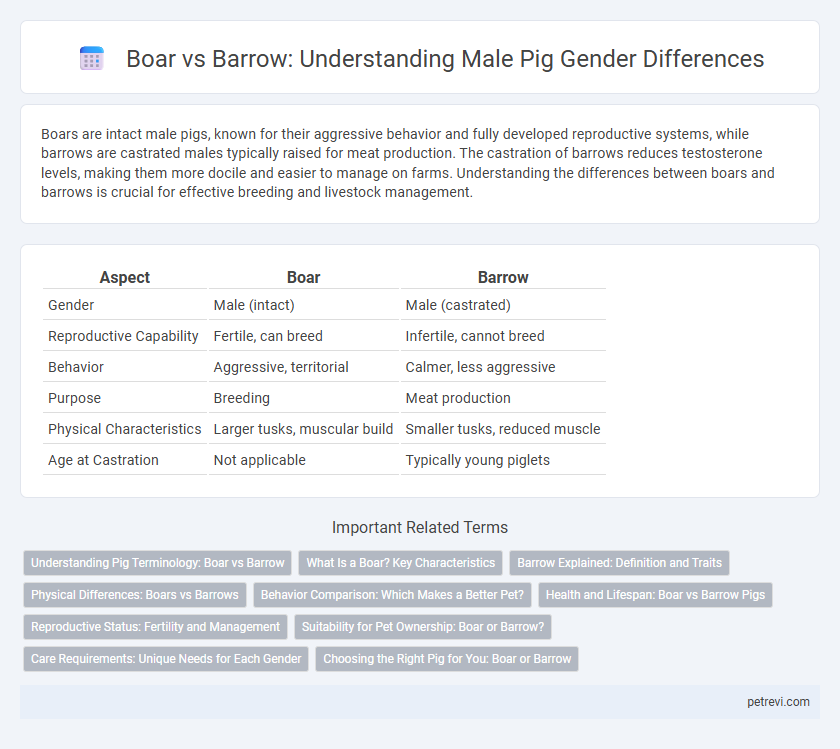Boars are intact male pigs, known for their aggressive behavior and fully developed reproductive systems, while barrows are castrated males typically raised for meat production. The castration of barrows reduces testosterone levels, making them more docile and easier to manage on farms. Understanding the differences between boars and barrows is crucial for effective breeding and livestock management.
Table of Comparison
| Aspect | Boar | Barrow |
|---|---|---|
| Gender | Male (intact) | Male (castrated) |
| Reproductive Capability | Fertile, can breed | Infertile, cannot breed |
| Behavior | Aggressive, territorial | Calmer, less aggressive |
| Purpose | Breeding | Meat production |
| Physical Characteristics | Larger tusks, muscular build | Smaller tusks, reduced muscle |
| Age at Castration | Not applicable | Typically young piglets |
Understanding Pig Terminology: Boar vs Barrow
A boar refers to an intact male pig, while a barrow is a castrated male pig, commonly raised for meat production due to their calmer behavior and improved fat distribution. Understanding this distinction is crucial for farmers managing breeding stock and optimizing pork quality. Proper identification of boars and barrows affects herd management strategies and market value.
What Is a Boar? Key Characteristics
A boar is an intact male pig known for its muscular build and prominent tusks, which are used for defense and dominance displays. Unlike barrows, which are castrated males, boars retain their reproductive capabilities and exhibit more aggressive behavior. The key characteristics of a boar include increased testosterone levels, a larger head, and a thicker neck compared to other pig genders.
Barrow Explained: Definition and Traits
A barrow is a castrated male pig, distinguished from an intact boar primarily by its altered hormonal profile, which affects behavior and growth patterns. Barrows generally exhibit more docile behavior and improved fat deposition, making them preferred in commercial pork production for consistent meat quality. The castration procedure performed early in life reduces aggressive tendencies and improves feed efficiency, traits critical for managing pig populations effectively.
Physical Differences: Boars vs Barrows
Boars are intact male pigs characterized by larger size, more muscular build, and the presence of visible testicles, while barrows are castrated males with a more rounded body and lack of testicles. Boars typically display a thicker neck and pronounced tusks, which are absent in barrows due to hormonal changes post-castration. The physical differences reflect hormonal influences on growth patterns, muscle development, and secondary sexual characteristics.
Behavior Comparison: Which Makes a Better Pet?
Boars, intact male pigs, exhibit more aggressive and territorial behavior compared to barrows, which are castrated males known for their calmer and more docile temperament. Barrows tend to be easier to manage as pets due to their reduced aggression and lower tendency to mark territory with strong odors. Choosing a barrow typically results in a more sociable and manageable companion pig, making them better suited for domestic environments.
Health and Lifespan: Boar vs Barrow Pigs
Boars, intact male pigs, often have a shorter lifespan than barrows due to increased aggression and risk of injury or disease from hormonal activity. Barrows, castrated males, typically exhibit calmer behavior and enhanced fat deposition which supports overall health and longevity. Studies indicate that castration reduces stress-related hormones, promoting better immune function and extended life expectancy in pigs.
Reproductive Status: Fertility and Management
Boars are intact male pigs with active reproductive capabilities, making them essential for breeding programs due to their high fertility and ability to sire multiple litters. Barrows are castrated male pigs, rendered infertile, primarily managed for meat production rather than reproduction. Effective management of boars requires monitoring fertility cycles and mating capacity, while barrows demand less intensive reproductive oversight, focusing instead on growth and feed efficiency.
Suitability for Pet Ownership: Boar or Barrow?
Boars, being intact male pigs, typically exhibit more aggressive and territorial behavior, making them less suitable for pet ownership compared to barrows, which are castrated males with calmer temperaments. Barrows tend to be easier to manage and socialize, reducing risks of aggressive incidents in a home setting. Their docile nature and reduced hormonal influences make barrows the preferred choice for families seeking pigs as pets.
Care Requirements: Unique Needs for Each Gender
Boars require careful management due to their aggressive behavior and stronger odor, necessitating secure housing and regular monitoring to prevent injuries and control scent. Barrows, being castrated males, exhibit calmer temperament and reduced aggression, allowing for easier handling and less stringent containment measures. Both require balanced nutrition and health care, but boars need more attention to behavioral control and environmental enrichment to ensure welfare.
Choosing the Right Pig for You: Boar or Barrow
Boars are intact male pigs known for their strong breeding capabilities and more aggressive behavior, making them suitable for breeding purposes but requiring careful handling. Barrows are castrated male pigs, generally calmer and easier to manage, ideal for meat production and farming operations focused on growth efficiency and temperament. Selecting between a boar or barrow depends on your specific needs, with boars favored for reproduction and barrows preferred for manageable, high-quality pork.
Boar vs Barrow for Pig gender Infographic

 petrevi.com
petrevi.com